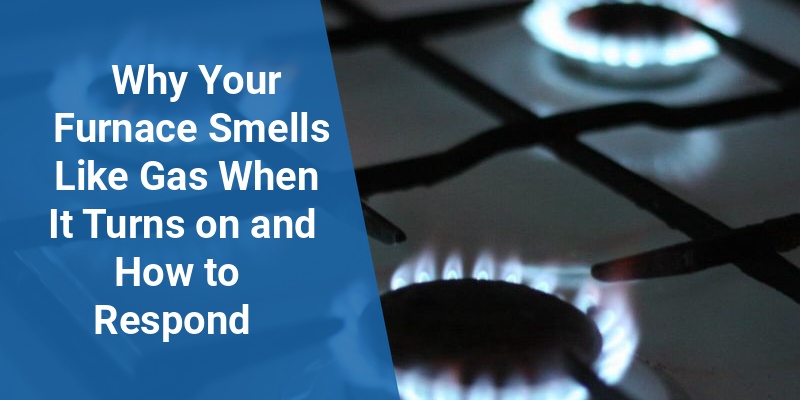Experiencing a gas smell when your furnace turns on can be alarming and potentially dangerous. This common issue often signals a gas leak or combustion problem that requires immediate attention. Understanding the causes, risks, and appropriate actions can ensure safety and maintain efficient furnace operation in American homes.
| Aspect | Details |
|---|---|
| Common Causes | Gas leaks, pilot light issues, clogged burners |
| Potential Risks | Fire hazards, carbon monoxide poisoning, explosion risk |
| Immediate Actions | Turn off furnace, ventilate area, call gas company and HVAC professional |
| Prevention Tips | Regular maintenance, detector installation, timely repairs |
Common Causes of Gas Smell When Furnace Turns On
Natural gas odors when starting a furnace usually come from leaks or combustion irregularities. The distinct sulfur-like smell is added by gas suppliers to detect leaks early. Key causes include:
- Gas Leaks: Loose or damaged gas connections around the furnace can let unburned gas escape into the air.
- Pilot Light or Igniter Problems: A pilot light that fails to ignite promptly allows gas to build up before burning.
- Clogged or Dirty Burners: When burners are blocked, the gas flow is uneven, potentially causing incomplete combustion and odor.
- Faulty Gas Valves: Valves that don’t shut off properly may leak gas during furnace startup.
Why Is a Gas Smell Dangerous?
A gas smell from your furnace is a serious safety concern. Natural gas is highly flammable, and if allowed to accumulate, it can cause explosions or fires. Additionally, incomplete combustion can produce carbon monoxide (CO), a colorless, odorless, and deadly gas. Even the added odorants in natural gas cannot detect CO leaks, so CO monitors are critical alongside gas scent detections.
Immediate Steps to Take When You Smell Gas from Your Furnace
Safety is the top priority when detecting a gas smell near your furnace. Follow these key steps immediately:
- Turn off the furnace and gas supply valve to stop further gas flow.
- Open windows and doors to ventilate the area and disperse gas buildup.
- Avoid activities that could cause sparks, such as turning on lights or using electronics.
- Evacuate everyone from the premises if the smell is strong or persistent.
- Call your local gas company or emergency services to report a possible leak.
- Contact a licensed HVAC technician to inspect and repair the furnace before using it again.
How HVAC Professionals Diagnose the Smell of Gas in Furnaces
When experts arrive, they use specialized tools and procedures to pinpoint the source, such as:
- Gas Leak Detectors: Electronic sensors to locate even minor leaks.
- Combustion Analyzers: To assess air-fuel mixtures and detect improper burning producing odors.
- Visual Inspection: Checking gas lines, burners, pilot assemblies, and valves for wear or damage.
- Pressure Testing: Ensures the gas supply system maintains safe pressure levels without leaks.
Preventive Maintenance to Avoid Gas Smells from Furnaces
Regular upkeep is essential to prevent gas odors and ensure safe furnace operation. Recommended steps include:
- Annual professional furnace inspections and tune-ups.
- Replacing filters and cleaning burners to maintain efficient combustion.
- Checking and tightening all gas connections yearly.
- Installing natural gas detectors and carbon monoxide alarms in living areas.
- Responding promptly to any unusual sounds, smells, or performance issues.
Understanding Furnace Gas Smells Versus Normal Burning Odors
It is important to differentiate between a hazardous gas smell and normal furnace odors, such as:
Call 888-906-9139 for Free Local HVAC Quotes – No Obligation, Just Savings!
| Type | Source | Description | Action |
|---|---|---|---|
| Natural Gas Smell | Gas leakage or incomplete ignition | Strong sulfur or rotten egg-like odor | Immediate evacuation and professional inspection |
| Burning Dust Smell | Heating system heating dust accumulated on heat exchanger | Brief, mild burnt dust odor at startup | Normal; ventilate area |
| Plastic or Electrical Burning Smell | Electrical shorts or mechanical failure | Sharp chemical or plastic odor | Turn off furnace and get inspection |
When to Replace Your Furnace to Mitigate Gas Smell Risks
Older furnaces or units with repeated gas odor issues may require replacement. Signs signaling the need for a new furnace include:
- Frequent pilot light or ignition failures.
- Visible corrosion or damage on gas lines and burners.
- Persistent gas odors despite repairs.
- High repair costs exceeding 50% of a new furnace price.
- Inefficient fuel consumption and increased utility bills.
Modern furnaces offer safer ignition systems, sealed combustion chambers, and better gas efficiency, significantly reducing gas leak risks.
Essential Tips to Ensure Safe Furnace Use in American Homes
- Never ignore a gas smell—immediate action prevents disaster.
- Install both natural gas detectors and carbon monoxide alarms near the furnace and sleeping areas.
- Schedule routine maintenance to catch wear and gas leaks early.
- Ensure proper ventilation around the furnace and in utility areas.
- Educate all household members about gas leak signs and emergency procedures.
